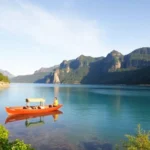Where to See Orangutans in Borneo

Did you know that in Bahasa (Malay), “orangutan” means ‘man of the forest’? This term comes from “orang hutan,” which translates to “man of the jungle,” vividly describing these fascinating primates. If you are planning your trip to Borneo and want to encounter these incredibly human-like creatures, keep reading. Today, I’m going to share with you the best places to see orangutans in Borneo.
Seeing them will be relatively easy, unfortunately, as their natural habitat is disappearing at an alarming rate. This has resulted in orangutans gradually concentrating in specific, well-known areas. For years, their survival has been threatened by various factors, pushing them to the edge of extinction.
This is a complex and sensitive issue, so in this article, I aim to provide you with insights to help you understand the situation of orangutans in Borneo. By doing so, you can prepare to enjoy the island's beauty and experience an unforgettable moment witnessing orangutans in their natural habitat. Keep reading for all the details!
Why are orangutans endangered?
Many factors have caused a drastic decline in orangutan populations over the past few decades. As is the case with most environmental issues, humans are primarily responsible.
But what are the threats that have led to orangutans being endangered? Here are the most significant:
1. Palm oil and orangutans
The palm oil industry has been the main driver of deforestation in Borneo. The palm oil tree is cultivated to produce palm oil, which is used in many everyday products: food, cosmetics, cleaning agents, and biofuels, among others.
Unfortunately, palm oil has numerous useful properties for these industries and is highly profitable, as once the trees start producing fruit, they can be harvested every two weeks throughout the year—there are no seasons, so it’s always a good time to harvest. Consequently, palm oil has become the most widely used oil globally. Alarmingly, 85% of its production is concentrated in Malaysia and Indonesia. But why specifically in Borneo?
This is primarily because these countries have vast available land for cultivation, and Borneo, being so pristine, provides optimal conditions for the fruit to grow faster than in other places. These fertile lands, ripe for cultivation and biodiversity, have become a double-edged sword, and governments have capitalized on them. After all, who doesn’t like money?
The greed of those in power has led to the scandalous deforestation of large parts of the island to cultivate palm trees. You can witness this firsthand as soon as you ride in a car or fly over the area. You’ll see endless kilometers of palm plantations, and it will break your heart.
2. Trafficking of orangutans
If that weren’t enough, the hunting and trafficking of orangutans also contribute to their population decline. Sometimes orangutans are hunted to be sold in the black market as pets or for entertainment shows, and infants are separated from their mothers to sell them as companions. Once they grow up and their owners realize they can no longer handle them, they are abandoned. A complete horror 🙁
3. Fragmentation of their natural habitat
Both deforestation and road construction have led to the orangutans’ natural habitat being reduced and divided into smaller sections. This inevitably makes it more challenging for them to move safely and find food or shelter.
This fragmentation causes a domino effect, as if orangutan populations become separated, their interactions are affected. If they interact less, genetic diversity decreases, which in turn increases the spread of diseases and, consequently, the chances of extinction. This is a very concerning situation that alarms all of us, except those who actually have the power to stop it.
All these factors have been crucial in the drastic decline of orangutan populations, and while it’s sad to say, there’s little indication that this will change in the near future. Therefore, experiencing the chance to see orangutans in Borneo becomes a unique and unforgettable opportunity.
How many orangutans are left in Borneo?
Although it’s difficult to provide an exact figure, it’s estimated that orangutan populations have declined by over 50% in the past three decades, which translates to the loss of hundreds of thousands of orangutans.
To give you a clearer picture, it was estimated that there were about 288,000 orangutans worldwide in 1973. However, currently, the estimate is around 104,700 orangutans in Borneo and approximately 14,600 on the island of Sumatra (Source). On average, it has been concluded that about 25 orangutans die each day.
With these figures, I’m sure you’ll never look at palm oil the same way again.
Orangutan rehabilitation centers in Borneo
Given these threats and considering that approximately only 50% of orangutans live in complete freedom, you can understand the necessity for rehabilitation centers that ensure and assist in orangutan survival.
These centers do a tremendous job with the orangutans, providing a safe haven for those rescued from illegal trafficking and those injured by poaching or habitat destruction.
The primary goal of these sanctuaries is to help orangutans develop survival skills and adapt to life in the jungle. Once they are ready, they are reintroduced into the wild in protected areas where they can live freely. Thus, rehabilitation centers contribute to the conservation of the species.
In addition to this, orangutans receive medical and psychological care to help them recover from the trauma and stress they may have experienced.
Globally, there are only three species of orangutans, all found in Indonesia and Malaysia. Here’s a brief overview of each:
› Sumatran orangutan (Pongo abelii)
This species is native to the island of Sumatra (Indonesia), and therefore, can only be seen there. As I mentioned earlier, it’s estimated that there are around 14,600 individuals in total, of which about 60% live freely, and the remaining 40% are in rehabilitation centers and/or captivity. Due to their low numbers, this orangutan is classified as “critically endangered.”
› Bornean orangutan (Pongo pygmaeus)
This species is native to Borneo, and although the island is divided among three countries (Malaysia, Indonesia, and Brunei), it can only be seen in the first two. This species has the largest population: around 104,000.
› Tapanuli orangutan (Pongo tapanuliensis)
This is the most recently discovered species, found in the Tapanuli region (Sumatra, Indonesia). Although it was rediscovered in 1997, it was only classified as a unique species in 2017 after more extensive research revealed that it is genetically and morphologically distinct from the other two orangutan species. It’s estimated that only 800 individuals exist.
As you can see, Borneo is home to the largest population of orangutans in the world, meaning there is a greater chance of seeing orangutans in their natural habitat here compared to other locations.
Moreover, Borneo features several national parks and rehabilitation centers specifically established to protect these animals and allow visitors to see them in a responsible and sustainable manner. This is essential.
In which areas of Borneo can you see orangutans?
You can see orangutans both in the Malaysian and Indonesian zones of Borneo, but sadly, a large percentage of orangutans are not in the wild. Hence, most places where you can see them will be in rehabilitation centers.
But don’t worry, these spaces have designated areas where orangutans can move freely, so they live in a state of semi-freedom until they can return to wild life.
In these rehabilitation centers, they are fed twice a day on a platform; however, the food is often scarce and monotonous: just small bananas. This is intended to ensure that those who have been recently introduced still receive some sustenance but not enough to be self-sufficient, thus encouraging them to develop foraging skills.
Once they learn to fend for themselves, they will stop coming for that “supplement” and will find sustenance independently. I witnessed this firsthand when I visited the Sepilok rehabilitation center, where out of the 44 or 45 individuals living there, only one approached the feeding platform.
This is why it’s advisable to visit these feeding points during both feeding times because this increases the chances of seeing them. The rest of the time, they will be roaming in the jungle, and you might not see them at all.
Where to see orangutans in Malaysian Borneo
The two best places to see orangutans in Borneo are Semenggoh Wildlife Center and Sepilok. Here are more in-depth details about each:
✓ Sepilok Orangutan Rehabilitation Centre (Sabah)
The “Sepilok Orangutan Rehabilitation Centre” is one of the most well-known orangutan rehabilitation centers in the world and is located in Sandakan, Sabah province.
This center was established in 1964 to assist in rehabilitating orphaned, injured, and illegally held orangutans, and has since evolved into a significant conservation center. Its focus is on healing and recovering affected individuals, and once they have learned to survive on their own in the jungle, they are released back into their natural habitat.
The sanctuary covers approximately 43 square kilometers and includes a visitor center, feeding platform, rehabilitation center, and research area.
- Hours: 9:00 AM to 11:00 AM and 2:00 PM to 3:30 PM.
- Price: 30 ringgit for adults and 15 ringgit for children.
- Feeding: at 10:00 AM and 3:00 PM.
✓ Semenggoh Wildlife Centre (Sarawak)
The “Semenggoh Wildlife Centre” is located in Sarawak province, about 20 km from Kuching, and is the largest sanctuary in the province. The primary objective of this center, established in 1975, is to rehabilitate rescued orangutans and help them develop the necessary skills to survive in the wild.
Here, they are also fed twice a day, but during the fruit season, the chances of them appearing decrease. Remember that in these centers, orangutans live in semi-freedom, so no one can guarantee 100% that you will see them. They might show up, or they might not. When you think about it, that’s the real charm of the place since their ultimate goal is total reintegration into the jungle, and if they don't appear, it means things are going well 🙂
In addition to the opportunity to see them at the feeding platforms, at Semenggoh, you can also learn more about them: their diet, lifestyle, characteristics, and conservation efforts for orangutans. You can find more information on their official website.
- Hours: 8:00 AM to 10:00 AM and 2:00 PM to 4:00 PM.
- Price: 10 ringgit (adults), 5 ringgit (children aged 6 to 18), free (under 6 years).
- Feeding: at 9:00 AM and 3:00 PM.
✓ Kinabatangan River (Sabah)
Although it’s unlikely, there is a possibility of seeing orangutans in complete freedom during the boat tours typically conducted on the Kinabatangan River.
As hope is the last thing to lose, I kept my eyes peeled until the very last moment during the three excursions, but luck was not on my side. However, the guide mentioned that the last sighting had been a month ago. So the possibility exists 😉 Even if you don’t spot any, the boat ride is beautiful, and the experience is very interesting.
Where to see orangutans in Indonesian Borneo
Just like in the Malaysian section, there are several places in Indonesia where you can see orangutans. Here are the most important:
✓ Tanjung Puting
This sanctuary is located in the Tanjung Puting National Park, in the Kalimantan province, and to reach it, you must take a short cruise on the Sekonyer River. The most typical option is to book a 3-day, 2-night tour aboard a klotok, a traditional boat that will become your home during the journey.
During this time, you’ll have the opportunity to see orangutans in freedom and visit the various camps scattered throughout the jungle, where you can enjoy orangutans in their natural habitat. As you know, these camps serve as bases for the rehabilitation and care of orangutans, so they live in a state of semi-freedom.
The most well-known camps where stops are typically made include Tanjung Harapan Camp, Pondok Tanggui Camp, and Camp Leakey (the most important recovery center in the park).
Important: this area is gaining popularity, and during the high season (from mid-June to September), many more boats are on the river. Therefore, the official website of the Tanjung Puting National Park recommends booking a shared boat during these dates to minimize the impact. They also advise against visiting the most crowded river destinations, as tourist influx is significantly higher.
✓ Other places to see orangutans in Indonesian Borneo
Although Tanjung Puting is the best place to see orangutans in the Indonesian section of Borneo, there are also other locations where you can do so:
- Gunung Palung National Park: to visit it, you will need to hire a tour or a local guide. The visit usually lasts several days, including treks through the jungle where you can see orangutans in freedom.
- Kutai National Park: orangutans can also be seen through trekking, similar to Gunung Palung; you’ll need to book a multi-day tour to delve into the jungle and spot them in the wild.
Recommendations for seeing orangutans in Borneo
Now that you know where to see orangutans in Borneo, here are some final tips to help you enjoy the experience ethically and respectfully:
- › Do not feed the orangutans: it’s crucial not to give them food as they may become dependent on humans and lose their ability to fend for themselves.
- › Do not get too close: orangutans are wild animals and can be dangerous if they feel threatened. Always maintain a safe distance and respect their personal space.
- › Avoid touching orangutans: although they may seem like plush toys you’d love to hug, remember that orangutans are wild animals. They are not pets, so do not attempt to touch or interact with them.
- › Choose a responsible agency: ensure that you choose a tour with an ethical company genuinely concerned about orangutans. Research, read reviews, and above all, compare. More expensive tours are not always the best.
- › Follow the guide’s instructions: if you are on a tour or with a local guide, follow their instructions to avoid disturbing the orangutans or disrupting their natural environment.
- › Respect the national park rules: if you visit a national park to see orangutans, take the time to learn about the rules that exist to protect the animals and their habitat.
- › Do not leave trash: be responsible and ensure you take all your trash with you. Besides polluting the environment and altering their habitat, trash can be dangerous for orangutans or other animals living in the jungle.
I hope this article has been useful in helping you discover the best places to see orangutans in Borneo and that you have also learned about the issues surrounding palm oil. Remember, if you have more questions, feel free to leave a comment below 🙂
| Save on your trip |
| Compare and find cheap flights here |
| Find accommodation at the best prices here |
| Book activities and excursions in Spanish here |
| Get a 5% discount on your travel insurance with IATI here |
| Reserve airport transfers here |
| Learn how to withdraw money without fees here |
| Get a 5% discount on your eSIM from Holafly here |
| The best travel books and guides here |
| All our articles about Malaysia |
* Some images obtained from Shutterstock






Deja una respuesta